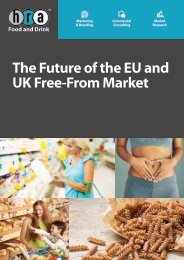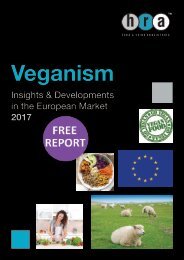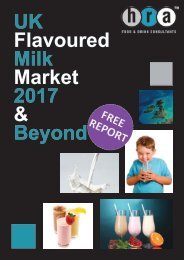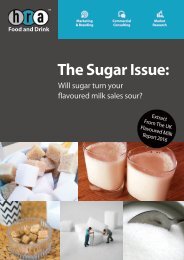FREE-UK-Flavoured-Milk-Report-2016-2017
The backdrop to the UK flavoured milk market is one of relentless change. The removal of the EU milk quotas, the transition to a Western-type diet by emerging economies, the UK sugar debate and the booming sports nutrition industry are all aspects of change that create both challenges and opportunities for the UK flavoured milk market. HRA Food and Drink Marketing has developed this report as a map to guide industry stakeholders. Although volume growth in 2014 was slightly lower than in previous years, the flavoured milk market still has plenty of room for product innovation and development. Overall, we expect the UK flavoured milk market to continue to grow over the medium term, but not without improving its nutritional profile. The sugar debate reached new heights when, in October 2015, Public Health England released a document suggesting Government intervention in the form of a sugar tax (levy). As a consequence, product reformulation has become a priority for all serious players in the market.
The backdrop to the UK flavoured milk market is one of relentless change. The removal of the EU milk quotas, the transition to a Western-type diet by emerging economies, the UK sugar debate and the booming sports nutrition industry are all aspects of change that create both challenges and
opportunities for the UK flavoured milk market.
HRA Food and Drink Marketing has developed this report as a map to guide industry stakeholders. Although volume growth in 2014 was slightly lower than in previous years, the flavoured milk market still has plenty of room for product innovation and development.
Overall, we expect the UK flavoured milk market to continue to grow over the medium term, but not without improving its nutritional profile. The sugar debate reached new heights when, in October 2015, Public Health England released a document suggesting Government intervention in the form of a sugar tax (levy). As a consequence, product reformulation has become a priority for all serious players in the market.
Create successful ePaper yourself
Turn your PDF publications into a flip-book with our unique Google optimized e-Paper software.
<strong>UK</strong>#FLAVOURED#MILK#<strong>2016</strong>217#<br />
#<br />
2.1 Key Trends from Chart:<br />
•#<br />
•#<br />
•#<br />
•#<br />
•#<br />
•#<br />
•#<br />
Brands Broadening their Target Consumer Base: This diagram<br />
illustrates the increasing number of flavoured milk brands he and<br />
demonstrates that many leading companies are trying to deliver to all<br />
customer segments of flavoured milk consumers.<br />
For example, Arla has a product in almost every sub-category: traditional<br />
flavoured milk, functional drinks with the protein added, flavoured milk<br />
packaged with sports caps as well as coffee, lactose-free and sugarreduced<br />
variants.<br />
Coffee Flavours on the Rise: The diagram also highlights that coffee is<br />
an increasingly popular flavour. Starbucks by Arla, Caffé Latte by Emmi<br />
and even dairy-alternative milk producers like Blue Diamond, Alpro and<br />
VitaCoco, have developed coffee flavoured propositions.<br />
Functional Drinks Becoming To Mainstream: Gain Access Another notable trend is<br />
functional drinks, a category that once belonged to a relatively niche<br />
Purchase The Full<br />
group consumers made primarily of athletes and weight lifters, is now<br />
becoming increasingly mainstream. <strong>Report</strong> <strong>Flavoured</strong> Nowmilk<br />
products high in<br />
protein are becoming increasingly merchandised alongside traditional<br />
flavoured milks.<br />
Targeted Packaging: The diagram demonstrates visually that the<br />
creation of flavoured milk products is not only about developing new<br />
formulas in the laboratory, but it is also about creating attractive,<br />
functional, efficient, convenient packaging that adapts to the consumer's<br />
needs and appeals to their aspirations.<br />
Rapid Growth: As flavoured milk is a fast growing category, brands are<br />
able to launch into several distribution channels at once, thus bringing<br />
scale to what is initially a niche proposition. This dynamic explains how<br />
quickly propositions like coconut and protein milk have grown so rapidly.<br />
Limited Own Label Innovation: Although this chart does focus solely on<br />
brands, this is largely down to the lack of innovation in own-label<br />
products.<br />
2.2 <strong>Flavoured</strong> <strong>Milk</strong> Trends<br />
2.3 White <strong>Milk</strong> Market Indicators<br />
•#<br />
•#<br />
•#<br />
Since 2009, historic value sales of white milk have been showing an<br />
overall negative compound annual growth rate (CAGR), meaning that<br />
white milk value sales are trending downwards.<br />
In terms of volumes sales, white milk has presented almost no CAGR with<br />
sales remaining almost constant.<br />
In contrast, over the past five years, flavoured milk has shown a positive<br />
value and volume CAGR.<br />
# 23#<br />
All rights reserved, ©Teepee#Ltd,#t/a#HRA#Food#&#Drink:#<strong>2016</strong>#<br />
to#<strong>2017</strong>#







